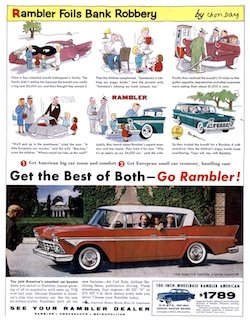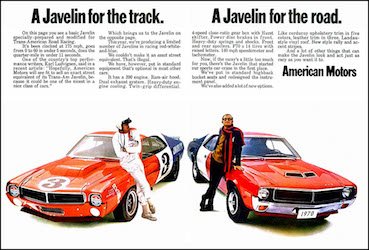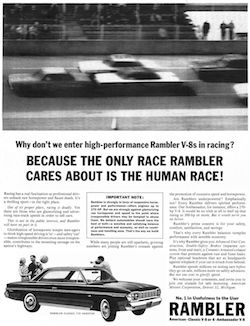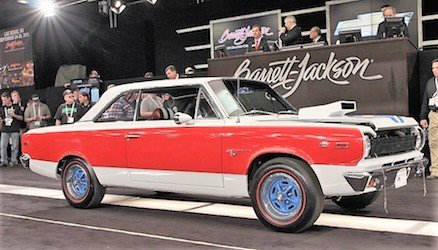Q: Hi Greg, I enjoy your old car articles very much in our weekly Pennysaver. I am an AMC fan and want to know the actual date when American Motors was formed, and a short history of why you feel they failed? Bob H. Owego, N.Y.
A: Bob, on May 1, 1954, American Motors Corporation (AMC) was born when Nash-Kelvinator and Hudson Motor Company joined forces to help offset the strong sales of the American “Big Three” of Ford, General Motors and Chrysler. At the time, it was the biggest merger in American business history.
Although Nash and Hudson were both popular in the early 1950s, the financially independent nature of both companies, it didn’t allow for the advanced design efforts afforded by the Big Three. Nash had excellent marketing under its top manager, George Mason, while Hudson won several titles on the early NASCAR circuit with its “Fabulous Hudson Hornet” 6-cylinder powered cars.
By 1956, both Nash and Hudson were in their final years of selling its “branded” vehicles while now parent AMC focused on its new name, Rambler, and smaller cars like the Metropolitan and American. To explain further about the “naming,” the all-new Ramblers were on dealer showroom floors in 1956 but carried either Hudson or Nash badges. In 1957, Hudson and Nash names were eliminated and Rambler was the new icon, although Nash had used the name earlier. Notable is another “name survivor” in Nash’s “Ambassador,” a badge that would live on for many years on larger AMC products after being re-introduced in 1958 as Rambler’s top line offering.

This advertisement heralding American motors in 1958 cites the company’s new economy car in cartoon form. AMC usually provided excellent advertising messages in print, radio and television and for a time made up the “Big Four” of car companies with GM, Chrysler and Ford. (Ad compliments of former American Motors)
Notable, too, is George Romney, the noted politician and former governor of Michigan, became American Motors CEO in October of 1954 when his mentor, the aforementioned Mason, died suddenly. Romney led a “Rambler charge” that allowed AMC to move forward with many popular family cars, including a “sleeper” 1957 Rambler with a 327 V8 that could run with a Corvette in acceleration trials.
Further down the road, AMC purchased the Jeep brand from Kaiser in 1970, and then partnered with French carmaker Renault in 1980 on new vehicle production. Renault then purchased controlling interest in AMC in 1984 to produce cars like the unreliable Alliance and sporty, yet still untrustworthy, Fuego. The Renault partnership was the beginning of the end.
Another of AMC’s corporate decisions that came back to bite them was its decision to stay out of high performance and professional racing. As performance boomed in the 1950s and both drag racing and NASCAR oval racing experienced major growth, GM, Ford, and Chrysler were all in on the racing game as were independents Nash and Hudson, the latter which won many early 1950 decade races. The old marketing jargon “win on Sunday, sell on Monday” was born, and it wasn’t long before the car companies were promoting high-performance and racing in both print and television advertising.
Everyone except Rambler, even though both Nash and Hudson had proven that racing sold cars.
Then, the Automotive Manufacturers Association (AMA) in 1957 issued a mandate that changed everything. The resolution called for de-emphasizing performance and racing in its car advertisements, which was agreed upon by all members. Not surprisingly, GM, Ford and Chrysler continued its racing programs full bore and legends of racing were born – all with factory support, be it official or not. Rambler, meanwhile, followed the resolution and did not build performance-oriented vehicles. Along the way, AMC also designed an “in your face” ad boasting, “The only race we’re concerned with is the human race,” which backfired and cost the company many sales as the muscle car boom evolved.

After realizing its mistake, AMC released one of its best known and very fast muscle cars, the 1969 AMC Hurst SC/Rambler. With proper gearing, headers, slicks and a bit of engine tuning, the car was capable of high 12-second quarter miles. This one sold in 2015 for $38,000. (Compliments Barrett-Jackson Auction)
Finally, in the late 1960s and 1970s, AMC arrived very late to the corporate racing party when it reversed its decision to not be involved in organized motor racing. Starting with the production of 390-V8 muscle cars in the second half of the 1960-decade, they followed up with sponsorship in professional drag racing, NASCAR and SCCA Trans-Am road racing and won in all three. Even the AMC Hornet, known previously as a family car usually with a six-cylinder under the hood, offered a beefed up model with a 343-V8 and four-speed transmission. Still, it took until 1967 for some real go-power to show up at AMC with both its drag racing nitro funny car and the remarkable lightweight 390 V8 powered Hurst SC/Rambler American.
Unfortunately, being late to the party has its consequences. Under profit and loss pressures, by 1978 AMC was forced to sell everything. Its partner, Renault, sold its 47% ownership stake in American Motors to Chrysler, resulting in Chrysler making a public offer to purchase all the remaining outstanding shares of American Motors stock, which Chrysler accomplished in August of 1987.
Renault, meanwhile, pulled out of the North American market in 1987 and its new Renault Medallion was sold through the newly formed Jeep-Eagle division of Chrysler as an Eagle badged car. The Jeep-Eagle division was formed to include the remaining American Motors Jeep Renault dealer network, with Jeep / Eagle vehicles marketed primarily by the former American Motors dealers. The American Motors’ badge was last used on the Eagle Sports Wagon through the 1988 model year, and then eliminated entirely. Eagle cars, meanwhile, were phased out by 1998.

How good was AMC as a professional, factory backed, race team? Very good! Roger Penske won championships in his Javelins in Trans-Am road racing and also won several big NASCAR Cup races with the factory AMC Matadors. (Compliments former American Motors)
Today the Jeep line still exists with its almost cult like following. Chrysler is now part of the Fiat and new partner (guess who?) Renault group and its Jeep brand continue as one of the company’s top sales leaders along with RAM pickups. So, thanks to Jeep, there’s still a tie that dates back to the AMC and Willys days.
There you have it, several reasons and mistakes AMC made along the way that were just plain irreversible. Personally I loved AMC, owned many of them, and hated to see them fail.
Matter of fact, I have a nice 1980 AMC Concord 2-door with 27,000 miles sitting in my garage right now – with the 258-six cylinder.
(Greg Zyla is a syndicated auto columnist who welcomes reader questions on collector cars, auto nostalgia and motorsports at greg@gregzyla.com).



Be the first to comment on "Cars We Remember – American Motors: one too many corporate blunders "